【2020(春)英语必修第三册外研版(新教材)】PartⅡ Usinglanguage——动词-ed形式作定语
(2020新教材)【外研版】高中英语必修第三册Unit 2 Developing ideas(英语)

2. assistance n. 帮助, 援助 *Despite his cries no one came to his assistance. 尽管他大声喊叫, 却没有人来帮助他。 *He can walk only with the assistance of crutches. 他只能在拐杖的辅助下走路。
③He hesitated _a_b_o_u_t_/a_t_/o_v_e_r_ whether to drive or take
the train. (2)If you need help to get out of trouble, _d_o_n_’_t _h_e_s_it_a_te_ _t_o_a_s_k_m__e_f_o_r_h__el_p_. 如果你需要帮助来摆脱困境, 只管向我寻求帮助。
Ⅰ. 文本整体理解: 理清文章架构
Ⅱ. 文本细节理解: 探寻语篇细节信息 1. What can we learn from Paragraph 1? A. The children were excited to board the train. B. The children boarded the train with their parents. C. All the children who boarded the train were Jewish. D. It was very likely that the parents would not see their children again.
(1) _b_o_a_r_d_e_d_(board) a train at Prague’s Wilson Station. Nicholas Winton would save them from death at the hands of the Nazis.
(2020新教材)【外研版】高中英语必修第三册Unit 2 Using Language(英语)

③This is the problem _b_e_in__g_d_i_s_cu__ss_e_d_(discuss) now. ④The airport _to__b_e_c_o_m__p_l_e_te_d_(complete) next year
will help promote tourism in this area. ⑤Jim has retired, but he still remembers the happy time _s_p_en__t (spend) with his students.
*Do you waຫໍສະໝຸດ t to see the doctor to be sent for from Beijing? 你想见那位将从北京被请来的医生吗?
【即学活用】语法填空 ①There are many beautifully _d_e_c_o_r_a_te_d_(decorate) houses in our area. ②The idea _p_r_e_se_n_t_e_d_(present) by Peter is much simpler.
【即学活用】 (1)句型转换 ①The house which was built 100 years ago stood still after the earthquake. →The house _b_u_i_lt_1_0_0__y_e_a_r_s_a_g_o_stood still after theearthquake.
三、不同非谓语动词形式作定语的区别
过去分词作定语 现在分词作定语
现在分词的被动形 式作定语
不定式作定语
表示被动或完成 表示主动或进行
表被动和进行 表示将要发生的动作
(2020新教材)【外研版】高中英语必修第三册Unit 2(英语)

Text 2 W: I bought a second-hand TV set on sale yesterday. It cost me $150. M: Only $150? Mine cost three times as much!
Text 3 M: I thought you were going to attend a meeting in Atlanta last Saturday. W: I was planning to, but I haven’t been feeling well, so I stayed at home.
【即时训练】 听对话回答下列问题。 1. What did the man like when he was in college? A. Rock music. B. Classical music. C. Pop music.
2. How much is the man’s TV set? A. $ 150. B. $ 300. C. $ 450. 3. What did the woman do last Saturday? A. She attended a meeting. B. She stayed at home. C. She travelled in Atlanta.
enough to give me a whole chapatti. He said, “Your need is greater than mine! ”
She remembered the poisoned chapatti that she had made that morning. Had she not burnt it in the fire, it would have been eaten by her own son!
新外研社高中英语必修三Unit2MakingADifference-UsingLanguage课件

【学法点拨】 ( 1)个别单个的过去分词,如 shown,adopted,left,given, involved, wanted,gained,concerned,provided 等作定语时习 惯后置。 After completing and signing it,please return the form to us in the
【误区警示】
( 1)某些表示人的情绪变化的动词,如 interest,bore,worry, frighten, surprise 等,通常用系表结构表示状态,其过去分词大多已转化为形容词, 因此,作定语时表示的是状态而不是被动含义,意为“感到……的”。
The frightened baby kept crying. 受到惊吓的婴儿不停地哭泣。
同义句转换
(1)The works shown at the exhibition are priceless.
= The works that are shown at the exhibition are priceless.
(2)Our teacher asked us to use the words given to make up sentences.
Thinking
Find out the difference of the these attributive
1. …Ryan had trouble believing the words spoken by his teacher… 2. In Uganda, Ryan at last saw the finished well… 3. What they needed was a well dug near their homes. 4. Many inspired people gave them their support.
外研版高一英语必修第三册(2019版)_Unit2_Using_language_精品课件(2)
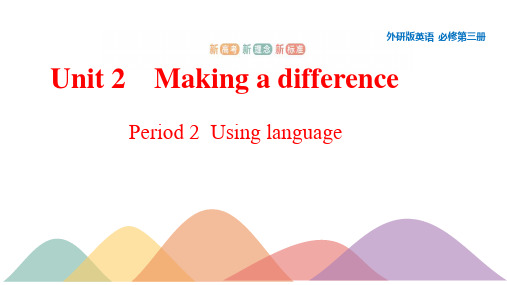
Practice
Rewrite the underlined sentences with the -ed form.
1 Ryan is a young man who is admired by a lot of people. Ryan is a young man ___________________________.
外研版英语 必修第三册
Unit 2 g a difference
Period 2 Using language
Using language
Verb-ed as attributive
Verb-ed as attributive
Identify the part of speech in the following sentences: ① In Uganda, Ryan at last saw the finished well with his own eyes. ② Many inspired people gave him their support. ③ Ryan had troubled believing the words spoken by his teacher. ④ A well built near a primary school in Uganda cost $2000.
① The verb-ed form can express the passive meaning.
Meanings ② The verb-ed form can express the past meaning. ③ The verb-ed form functioning a common adjective can express one’s feeling.
(2020新教材)【外研版】高中英语必修第三册Unit 2(英语)

A woman baked chapatti for members of her family and an extra one for a hungry passerby. She kept the extra chapatti on the window sill. Every day, a hunchback came and took away the chapatti. Instead of expressing gratitude, he muttered the following words as he went his way: “The evil you do remains with you; The good you do comes back to you! ”
It was then that she realized the significance of the words: “The evil you do remains with you; The good you do comes back to you! ” Do good and don’t ever stop doing good, even if it is not appreciated at that time.
As she was about to keep it on the window sill, her hands trembled. “What is this I am doing? ” she said. Immediately, she threw the chapatti into the fire and prepared another one. As usual, the hunchback came, picked up the chapatti and muttered the words: “The evil you do remains with you; The good you do comes back to you! ”
(新教材)高中英语外研版必修第三册 Unit 3 Section B Using language
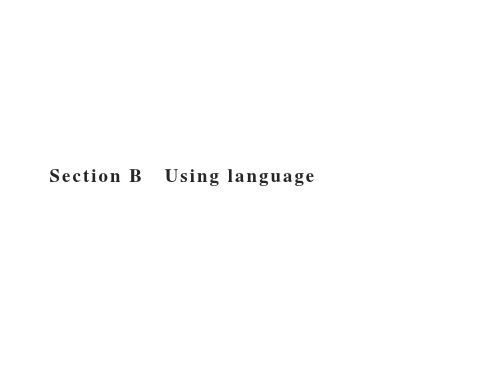
puters have been used in offices and homes since the 1970s. 5.The programme has been broadcast many times by the local radio station.
重
点 语
现在完成时的被动语态
法
Ⅱ.词汇拓展
1.passive→ active (反义词)
2.significant→ significance (n.)
3.injure→ injured (adj.)→ injury (n.)
4.accurate→ accurately (adv.)
5.origin→ original (adj.)→ originally (adv.)
句 2.British biologist Charles Darwin(1809-1882) is best known for
式 his work On the Origin of Species,in which he explains changes in species due to natural selection.
【词汇精讲】本句中beyond是介词,意为“超出……范围;超越;无 法……”。beyond recognition在本句中意为“超出想象,认不出来”。 beyond还可以作副词用,意为“在远处;在更远处”。
(2018全国Ⅰ卷)I managed to get an A in that course and learned life lessons that have served me well beyond the classroom.
高中英语必修三(外研版)2-2Using language教学课件
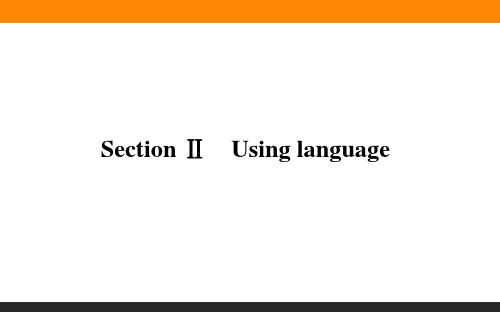
(3)她毫不犹豫地接受了我的提议。 She _h_a_d_n_o__h_e_s_it_at_i_o_n_i_n____ accepting my offer. (4)只要你考虑清楚了,就不要犹豫你的决定。 Don't _h_e_s_it_a_te__a_b_o_u_t ____ your decision once you udent gets hungry on the long drives to and from school, Wilson never hesitates to buy them a meal.
如果一个学生在往返学校的长途汽车上饿了,威尔逊会毫 不犹豫地给他们买一顿饭。
(1)hesitate to do sth. 迟疑做某事;不愿做某事 hesitate about/over (doing) sth. (做)某事犹豫不决 (2)hesitation n. 犹豫,迟疑 without hesitation 毫不犹豫地 have no hesitation in doing sth. 很乐意做某事
be generous with sth. 不吝惜某物 be generous to sb. 对某人慷慨 It is generous of sb. to do sth. 某人做某事真是慷慨大方 generously adv. 慷慨地,大方地 generosity n. 慷慨,大方
[即学即练] 单句语法填空
hull(船壳) of the boat. 我迅速地游向父亲并帮助他爬上船。 ③You will be required to assist Professor Smith in preparing a
(新)外研版英语必修第三册课件:Unit 2 Making a difference 第二课时 Using language

[归纳拓展] (1)extend to/into 延续,延伸到…… extend from...to... 从……一直延伸到…… extend a helping hand to sb. 向某人伸出援助之手 (2) extension n. 延伸;扩大;延长期
[易混辨析] 伸出;延伸。指空间范围的扩大,以及长度、宽度的
vt. 使人
丧失能力;使残疾→ disabled adj. 残废的;有残疾的
5. sensitive adj. 敏感的;易受伤害的;灵敏的→ sensitively adv. 敏感地;灵敏地→ sense n. 感觉
6. generous adj. 慷慨的;大方的→ generously adv. 慷 慨地;宽大地;丰盛地→ generosity n. 慷慨;大方;宽宏大量
Unit 2
Making a difference
第二课时 Using language自主预习来自单元语法考点探究 随堂演练
课时作业
Ⅰ.词汇初探
1. extend vt. 延长;延伸;持续→ extension n. 扩
大;延伸
2. mission n. 职责;使命
3. disease n. 疾病,病 4. disability n. 失去能力;伤残→ disable
2.He always knows how to make wise decisions.(P18) 他总是知道如何做出明智的决定。
Ⅳ.语法初探——单句语法填空 1.Larger amounts of caffeine can cause a problem called (call) caffeinism. 2.To return to the problem of water pollution, I'd like you to look at a study conducted (conduct) in Australia in 2012. 3.In art criticism, you must assume the artist has a secret message hidden (hide) within the work. 4.The producer comes regularly to collect the cameras returned (return) to our shop for quality problems. 5.In some languages, 100 words make up half of all words used (use) in daily conversations.
高中英语新教材外研版必修第三册课件:UNIT 2 Making a difference Section B Using Language
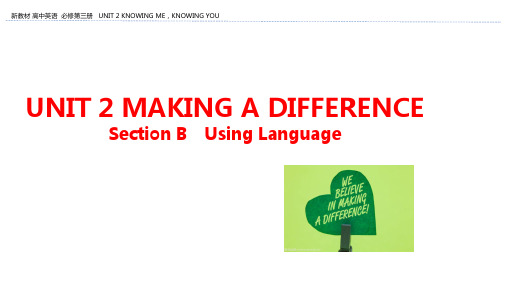
of his spare time. Though his wife has always complained about it,he still takes the work up. 自从
杰克接受了那份做编辑的工作以来,他便开始编辑文章,这占用了他的大部分业余时间。尽
管他的妻子一直对此抱怨,但他仍然继续他的工作。
of six months.
(3)With the road of our village__ex_t_e_n_d_e_d__(extend),it is convenient for us to travel outside.
新教材 高中英语 必修第三册 UNIT 2 KNOWING ME,KNOWING YOU
The disabled (people) (6)/P__eo_p__le_(__T_h_o_s_e_)__w_i_th__d_i_sa_b_i_lities (残疾人)also have the right to live a normal life.
新教材 高中英语 必修第三册 UNIT 2 KNOWING ME,KNOWING YOU
新教材 高中英语 必修第三册 UNIT 2 KNOWING ME,KNOWING YOU
词汇二 extend v. 持续;延伸
◆要点必记
extend a road/house 扩建公路 / 房子 extend the deadline 延长最后期限
◆单词积累
extension n. 扩大,延伸
extensive adj. 广阔的,广大的
take on 雇用;呈现
take off 取下;脱下;拆下;突然成功;起飞
新教材 高中英语 必修第三册 UNIT 2 KNOWING ME,KNOWING YOU
2020-2021学年新外研版选择性必修三:Unit2 课件

sentences with predicative clauses. Listen again if 1 that it comprises an array of plants
necessary.
adapted to dry conditions
2 that it is the life’s work of only one
_______________________________________.
外研社高中英语必修第三册3-2 Using languages 课件(2)
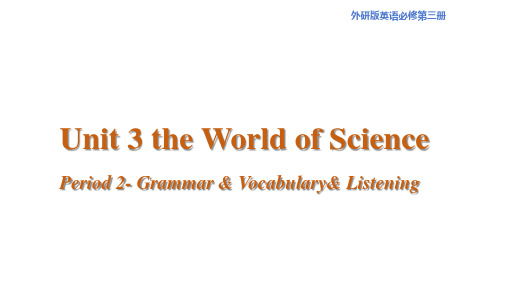
Vo c a b u l a r y
Activity-2 Complete the introductions about different scientists with the words in last activity. Pay attention to the
language that describes their careers.
Grammar
Activity-3&4 Rewrite the underline parts using present perfect passive.
____________________________________________________________ ____________________________________________________________ ____________________________________________________________ ____________________________________________________________ ____________________________________________________________ ____________________________________________________________ ____________________________________________________________ ____________________________________________________________
Vo c a b u l a r y
2020-2021学年新教材英语外研版必修第三册:Unit 3 (二) Using
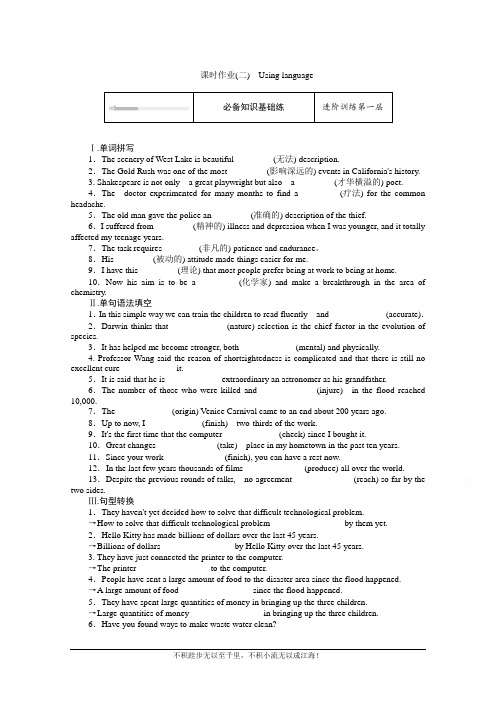
课时作业(二)Using language必备知识基础练进阶训练第一层Ⅰ.单词拼写1.The scenery of West Lake is beautiful ________ (无法) description.2.The Gold Rush was one of the most ________ (影响深远的) events in California's history.3. Shakespeare is not only a great playwright but also a ________ (才华横溢的) poet.4.The doctor experimented for many months to find a ________ (疗法) for the common headache.5.The old man gave the police an ________ (准确的) description of the thief.6.I suffered from ________ (精神的) illness and depression when I was younger, and it totally affected my teenage years.7.The task requires ________(非凡的) patience and endurance。
8.His ________ (被动的) attitude made things easier for me.9.I have this ________ (理论) that most people prefer being at work to being at home.10.Now his aim is to be a ________ (化学家) and make a breakthrough in the area of chemistry.Ⅱ.单句语法填空1.In this simple way we can train the children to read fluently and ____________ (accurate).2.Darwin thinks that ____________ (nature) selection is the chief factor in the evolution of species.3.It has helped me become stronger, both ____________ (mental) and physically.4. Professor Wang said the reason of shortsightedness is complicated and that there is still no excellent cure ____________ it.5.It is said that he is ____________ extraordinary an astronomer as his grandfather.6.The number of those who were killed and ____________ (injure) in the flood reached 10,000.7.The ____________ (origin) Venice Carnival came to an end about 200 years ago.8.Up to now, I ____________ (finish) two-thirds of the work.9.It's the first time that the computer ____________ (check) since I bought it.10.Great changes _____________ (take) place in my hometown in the past ten years.11.Since your work _____________ (finish), you can have a rest now.12.In the last few years thousands of films _____________ (produce) all over the world.13.Despite the previous rounds of talks, no agreement _____________ (reach) so far by the two sides.Ⅲ.句型转换1.They haven't yet decided how to solve that difficult technological problem.→How to solve that difficult technological problem ________________ by them yet.2.Hello Kitty has made billions of dollars over the last 45 years.→Billions of dollars ________________ by Hello Kitty over the last 45 years.3. They have just connected the printer to the computer.→The printer ________________ to the computer.4.People have sent a large amount of food to the disaster area since the flood happened.→A large amount of food ________________ since the flood happened.5.They have spent large quantities of money in bringing up the three children.→Large quantities of money ________________ in bringing up the three children.6.Have you found ways to make waste water clean?→__________________ ways to make wast water clean ________________ by you?7.We have planted many trees on the hill so far.→Many trees ________________ on the hill by us so far.Ⅳ.完成句子1.纸币已被使用了1000多年。
外研版高中英语必修第三册Unit2 Section Ⅱ Using language讲义
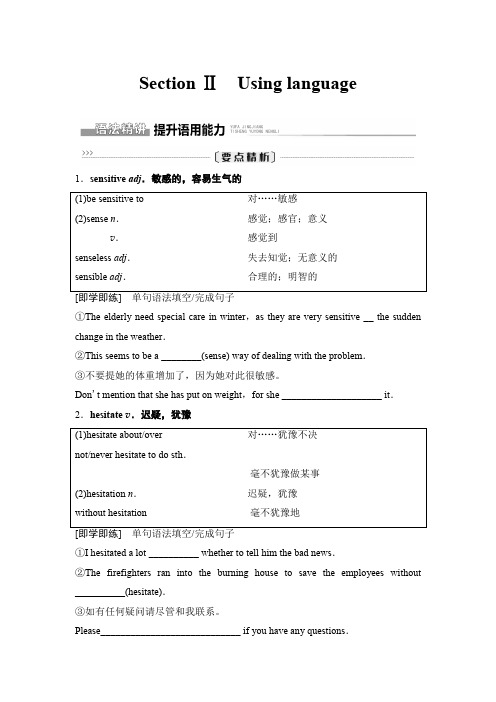
Section ⅡUsing language1.sensitive adj.敏感的,容易生气的(1)be sensitive to对……敏感(2)sense n.感觉;感官;意义v.感觉到senseless adj.失去知觉;无意义的sensible adj.合理的;明智的①The elderly need special care in winter,as they are very sensitive __ the sudden change in the weather.②This seems to be a ________(sense) way of dealing with the problem.③不要提她的体重增加了,因为她对此很敏感。
Don't mention that she has put on weight,for she ____________________ it.2.hesitate v.迟疑,犹豫(1)hesitate about/over对……犹豫不决not/never hesitate to do sth.毫不犹豫做某事(2)hesitation n.迟疑,犹豫without hesitation毫不犹豫地①I hesitated a lot __________ whether to tell him the bad news.②The firefighters ran into the burning house to save the employees without __________(hesitate).③如有任何疑问请尽管和我联系。
Please____________________________ if you have any questions.3.assistance n.帮助,援助(1)with the assistance of在……的帮助下come to one's assistance帮助某人(2)assist v.帮助,协助assist sb.with sth./in doing sth.帮助某人(做)某事(3)assistant n.助手,助理[即学即练]片段语法填空/词汇升级①Mary,a shop _________(assist) in a clothes shop,is a nice person and usually _______(assist) her neighbours ____ a lot of things.So they like her very much.Several years ago,Mary fell off a ladder and injured her right leg badly.Fortunately,her neighbour Lucy,who is a nurse,came to her __________(assist) when she heard the bad news.____ the assistance of Lucy,Mary is recovering quickly now.②Teddy came to help me immediately I told him my wallet had been stolen.→Teddy _____________________ immediately I told him my wallet had been stolen.(assistance)P221._________ 挖井2.______________ 缺水3.______________ 同意某人的观点4.__________________________________ 再利用水的新技术P231._____________ 总部设在……2.__________________ 为某人提供某物3._______ 开始从事4.________________ 被……影响5.___________________ 做出英明决定6._________________________ 毫不犹豫做某事7.__________________ 把某物托付给某人;放心地把某物交给某人8.__________________ 对……有信心9._________________ 幽默感10.___________ 使某人高兴/振作起来P241._____________ 做慈善2.___________ 偶遇3.___________ 筹钱4.____________________________ 在……中扮演重要角色5.__________________________ 残疾儿童6._______________ 适合7.__________________ 一周三次8.____________ 照管,照顾P251._______________________ 打算做志愿者工作2.___________ 尽管,虽然3.__________ 做笔记4.______________ 参与,参加过去分词作定语一、过去分词作定语的位置1.单个的过去分词作定语时,通常将其放在被修饰的名词之前。
2019-2020学年高中新教材外研英语必修第三册教师用书:Unit 2 Section Ⅲ Using language Word版含解析
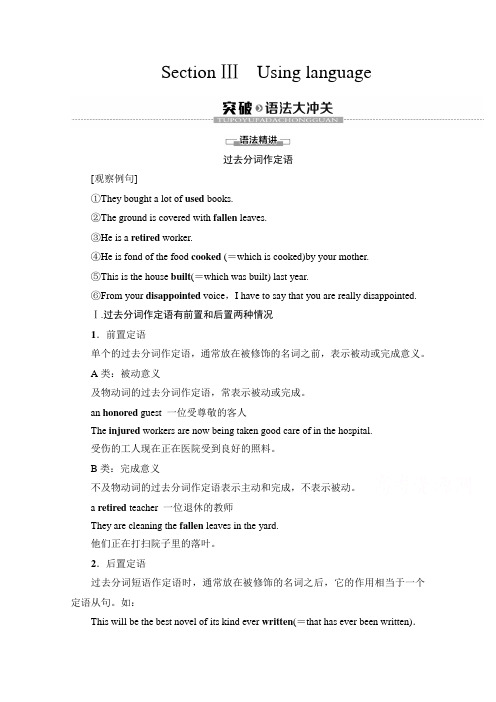
Section ⅢUsing language过去分词作定语[观察例句]①They bought a lot of used books.②The ground is covered with fallen leaves.③He is a retired worker.④He is fond of the food cooked (=which is cooked)by your mother.⑤This is the house built(=which was built) last year.⑥From your disappointed voice,I have to say that you are really disappointed.Ⅰ.过去分词作定语有前置和后置两种情况1.前置定语单个的过去分词作定语,通常放在被修饰的名词之前,表示被动或完成意义。
A类:被动意义及物动词的过去分词作定语,常表示被动或完成。
an honored guest 一位受尊敬的客人The injured workers are now being taken good care of in the hospital.受伤的工人现在正在医院受到良好的照料。
B类:完成意义不及物动词的过去分词作定语表示主动和完成,不表示被动。
a retired teacher 一位退休的教师They are cleaning the fallen leaves in the yard.他们正在打扫院子里的落叶。
2.后置定语过去分词短语作定语时,通常放在被修饰的名词之后,它的作用相当于一个定语从句。
如:This will be the best novel of its kind ever written(=that has ever been written).这将是这类小说中写得最好的。
Who were the socalled guests in vi ted(=who had been invited) to your party last night?昨晚被邀请参加你的晚会的那些所谓的客人是谁呀?Ⅱ.不定式、现在分词和过去分词作定语时的区别不定式作定语通常放在所修饰词之后,表示将来的动作。
外研社高中英语必修第三册4-2 Using languages 课件(1)

Activity 1 Look and compare the expressions underlined.
a
And just look at how the wind is folding her dress!
And just look at how her dress
is being foldebydthe wind!
As the old saying goes, the first step is always difficult.
It is never easy for me to hold a Chinese brush and handle it.
However, its unique lines ,rules for writing Chinese characters
6. The colored lights room.
are being w(hriattnegn) up across the
Vo c a b u l a r y
Activity 4 Look at the pictures showing Chinese art forms and know some art terms.
are being painted
2
Some people are trimming trees into interesting shapes. ➞
Trees are being
into interesting shapes by some peoples.
3
trimmed
Construction workers are building
by people everywhere you look.
- 1、下载文档前请自行甄别文档内容的完整性,平台不提供额外的编辑、内容补充、找答案等附加服务。
- 2、"仅部分预览"的文档,不可在线预览部分如存在完整性等问题,可反馈申请退款(可完整预览的文档不适用该条件!)。
- 3、如文档侵犯您的权益,请联系客服反馈,我们会尽快为您处理(人工客服工作时间:9:00-18:30)。
Part ⅡUsing language——动词-ed形式作定语【思维导图】1.动词-ed形式作定语相当于形容词。
2.动词-ed形式作定语,既可以放在被修饰名词的前面也可以放在被修饰名词的后面,即“名词+动词-ed形式”或者“动词-ed形式+名词”。
3.作定语的动词-ed形式,绝大多数是及物动词,只有少数几个是不及物动词。
过去分词作定语表被动、完成或两者兼有。
一、基本特征感悟【感悟用法】①The lost time can never be found again.②What’s the language spoken in that area?③I thought I would be punished for the broken glasses but I ended up being praised for my honesty.④Is there anything planned tonight?⑤The movie called Hero was famous for its special techniques.⑥The student dressed in white is my daughter.⑦This will be the best novel of its kind ever written.⑧Who were the so-called guests invited to your party last night?⑨This is the funniest news found on the Internet.⑩We were told we would meet at given time and place.【自我总结】11.过去分词作前置定语的有:①③⑩句,过去分词作后置定语的有:②④⑤⑥⑦⑧⑨句。
2.单个分词作定语的有:①③④⑦⑩句。
3.表被动意义的有:②⑤句;表完成意义的有:①⑩句;表被动完成的有;③④⑦⑧⑨句;表状态的有⑥句。
二、主要用法精讲1.动词-ed形式作定语的位置(1)单个的动词-ed形式作定语,通常置于被修饰词前。
the broken clock坏了的钟表the stolen backpack被偷走的背包(2)动词-ed短语作定语,常置于被修饰词后,相当于一个定语从句。
Most of the people invited to the party didn’t come.=Most of the people who were invited to the party didn’t come.大部分被邀请参加派对的人没有来。
名师提醒(1)有些单个的动词-ed形式,在习惯上往往置于被修饰词后。
There is little time left.时间不多了。
(2)动词-ed形式修饰something,everything,anything,nothing,nobody等不定代词或those时,常置于这些词的后面。
There will be something changed.有些东西要改变了。
He is one of those invited.他是那些被邀请的人之一。
(3)有些过去分词作定语,前置和后置的意义不同。
the tool used使用过的工具the used tool 旧的工具2the concerned expression担忧的表情the student concerned有关的学生名师提醒(1)英语中有很多与感觉有关的及物动词,其动词-ed形式有被动意义,即“使人产生某种感觉”。
moved受感动的amused 感到有意思的pleased 高兴的(2)有些及物动词的动词-ed形式作定语,并不强调被动意义,而表示一种状态或结果。
Dressed in white,she looked very beautiful.穿着白衣服,她看起来很漂亮。
The boy seated at the back of the classroom is clever.坐在教室后面的这男孩很聪明。
名师提醒人的表情、声音如look,expression,voice,sound,tear等用过去分词修饰。
There was a surprised look on her face seeing what have happened.看到所发生的事情后,她脸上出现了惊讶的表情。
2.动词-ed形式作定语的意义不及物动词的动词-ed形式作定语,只表示动作已完成;而及物动词的动词-ed形式作定语,表示被动意义或已完成,抑或两者兼具。
(1)只表示完成,不表示被动。
boiled water=water that has boiled开(过的)水the fallen leaves=the leaves that have fallen落叶3a developed country=a country which has developed发达国家(2)表示被动。
an honoured guest一位受尊敬的客人deeply moved people深受感动的人们(3)表示被动和完成。
the broken glass碎了的杯子the question discussed yesterday昨天讨论的问题3.动词-ing形式与动词-ed形式的区别(1)动词-ing形式表示主动意义,动词-ed形式一般表示被动含意。
(2)动词-ing形式表示正在进行,动词-ed形式表示状态或做完(完成)的事。
He rushed into the burning house.他冲进了正在燃烧着的房子。
The child standing over there is my brother.站在那儿的男孩子是我弟弟。
The room facing south is our classroom.朝南的房间是我们的教室。
Have you got your watch repaired?你拿到那个修好的表了吗?He is an advanced teacher.他是个先进教师。
(3)动词-ing形式和动词-ed形式作定语的区别动词-ed形式作定语时用于描述某人或某物的感受或状态;动词-ing形式作定语时用于描述由什么原因引起某人的感受。
Interested members will meet at two o’clock.感兴趣的会员在两点碰头。
As far as I’m concerned,this is an interesting film.就我而言,这是一部令人感兴趣的影片。
即学即练①The first textbook written(write) for teaching English as a foreign language came out in the 16th century.②Don’t use words,expressions or phrases known(know) only to people with specific knowledge.③The broken(break) glass cup was broken by Jim.④I like eating frozen(freeze) food while he doesn’t.⑤You’d better use the boiled(boil) water to make tea.⑥Have you read the novel written(write) by him?4⑦The fallen(fall) leaves will be collected by the cleaners.⑧Tsinghua University,founded(found) in 1911,is home to a great number of outstanding figures.Ⅰ.补全句子1.Jim sold most of his things.He has hardly__anything__left(没剩什么) in the house. 2.The problem discussed__at__the__meeting__yesterday(在昨天会议上讨论的) was very difficult to solve.3.The people exposed__to__sunshine(暴露在阳光下的) got sunburnt.4.The girl dressed__in__blue(穿蓝色衣服的) is my friend who is from Australia. 5.The English today is quite different from the English spoken__300__years__ago(300年前所说的).6.Most of the artists invited__to__the__party(被邀请去参加聚会的) were from South Africa.7.The students encouraged__by__the__teacher(受到老师鼓舞的)worked harder than ever before.8.People__concerned (有关人员) have been invited here to discuss what to do next. Ⅱ.同义句转换1.The meeting which was held yesterday is of great importance.→The__meeting__held__yesterday__is__of__great__importance.2.The speaker answered all the questions that were raised by the audience.→The__speaker__answered__all__the__questions__raised__by__the__audience. 3.Nine out of ten women who were interviewed about the product said they liked it. →Nine__out__of__ten__women__interviewed__about__the__product__said__they_ _liked__it.4.I don’t like going to the supermarket located in the centre of the town.→I__don’t__like__going__to__the__supermarket__which/that__is__located__in__th e__centre__of__the__town.55.The managers will again discuss the plan which was carried out last week.→The__managers__will__again__discuss__the__plan__carried__out__last__week.6。
